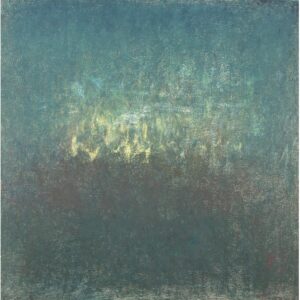Rebecca Purdum
The beauty of her abstractions are Rebecca Purdum’s greatest appeal, bringing to mind both late Monet and Color Field. Yet what delights me the most about her website is the plain-spoken, no-nonsense artist’s statement which is admirably titled: “A few words”:
To start a painting, I look at a surface of infinite possibility. How to find the one image that will be this painting? How to paint something I’ve never seen before? Even after making hundreds of paintings, it is still possible. That anticipation, and its affirmation when a painting is finished, is why I paint abstractly.
Whether a painting is nine feet or sixteen inches, they begin the same way. During the process of painting, however, many factors influence what happens next. Early on, it’s one-sided with my decisions propelling the action. As the surface grows, a shift occurs so that what I want is no longer important. The painting dictates what it needs. I know the painting is finished when what I see has a physical and emotional resonance, unique in time and place. That’s why all the paintings are different.
By contrast, I offer a sample from www.artybollocks.com, the random AI artist statement generator. First results upon clicking the words “generate some bollocks”:
My work explores the relationship between the universality of myth and recycling culture. With influences as diverse as Rousseau and Francis Bacon, new insights are distilled from both mundane and transcendant meanings.
Ever since I was a pre-adolescent I have been fascinated by the essential unreality of the zeitgeist. What starts out as hope soon becomes manipulated into a carnival of defeat, leaving only a sense of nihilism and the unlikelihood of a new synthesis.
As temporal forms become frozen through studious and critical practice, the viewer is left with a clue to the possibilities of our era.
Love that last sentence. At the bottom was a link asking “still not good enough?” Who could resist? I clicked up this:
My work explores the relationship between the Military-Industrial Complex and copycat violence. With influences as diverse as Caravaggio and Joan Mitchell, new insights are created from both orderly and random layers.
Ever since I was a child I have been fascinated by the theoretical limits of relationships. What starts out as yearning soon becomes corroded into a carnival of futility, leaving only a sense of what could have been and the chance of a new order.
As shifting forms become transformed through emergent and critical practice, the viewer is left with a clue to the limits of our world.
With influences as diverse as Monty Python and Woody Allen, the bollocks generator does a nice job of impersonating the average statement, but this carnival of pretention can’t compete with the way Purdum just sticks to the craft and doesn’t try to say what can only be shown. As someone once put it: “What can be said at all can be said clearly, and what we cannot talk about we must pass over in silence.”

Comments are currently closed.